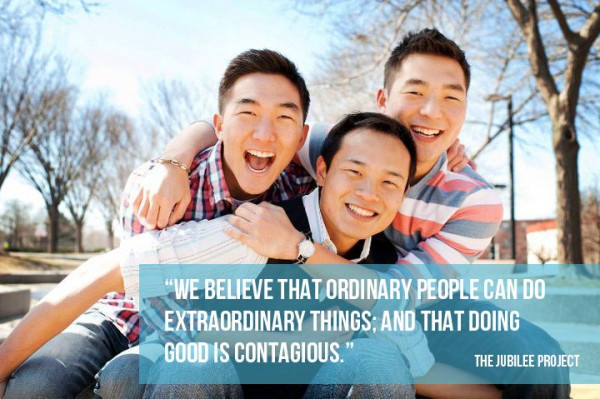Recently, CauseVox chatted with Jason Lee, one third of the infectious (in a good way) trio over at the Jubilee Project, a non-profit that produces videos to promote good causes. In its first two years of operations, the Jubilee Project has created over 70 videos, raised over $30,000 for 15 different non-profit organizations, garnered over four million views on YouTube, and has demonstrated, in accordance with one of their favorite sayings, that #DoingGoodIsContagious.
Here’s what we learned from Jason:
- Tell your story. This will engage the community. Make people understand why their support is needed, and help them develop an emotional connection to the cause. Getting supporters to “buy-in,” not just with dollars, but also with their emotions, is key to a successful campaign. This doesn’t mean that you have to dramatize your issue. Instead, just share what made you so passionate, and the rest should fall into place.
- Leverage the power of the little network. You don’t need a vast email list to reach a big fundraising goal. As Jason reminded us, “Ordinary people can do extraordinary things.” The members of the Jubilee team recently raised over $40,000 for Jubilee’s “End of AIDS” campaign on CauseVox by connecting with their personal contact circles (friends, acquaintances, mentors, etc.) and the subscriber base they’ve created on YouTube.
- Be consistent, but don’t spam. More messages ≠ more money. You don’t want to turn your audience off by being overbearing. As Jason explained, “Early in the campaign, we were sending out messages to our contacts once every week to two weeks.” Consistency, however, IS important. Keep your supporters and network in the loop and don’t disappear when you’re running a campaign.
- Share the urgency. A cause with no deadline may struggle, but if your fundraising campaign has a do-or-die date, supporters will understand the urgency of your issue. Donations may come in slowly at the beginning, but in the final weeks and days, when a goal is nearing, an excitement builds that can be totally contagious and that can push you over the top. Also, this final push brings your community together. For the “End of AIDS” campaign, some supporters called in to Jubilee as soon as the goal had been reached saying, “We did it!” That’s how you want your supporters to feel.
- Social media. Duh. But just for the sake of validating what everyone already knows: use Facebook and Twitter. The ease of sharing things on social media is what lets a non-profit reach people many degrees of separation apart and bond them together into a new community rallied around the cause.
- Be honest. Some cheerleading is necessary, but you can share your struggles with your supporters, too. If they understand that reaching the goal is uncertain, they may be more inspired to give support and take action. You want the community to know that they’re on the journey with you, and that, without help from each of them, the cause might fail.
- Try to use video. Video is a really effective storytelling tool. You may not be as skilled as the Jubilee Project guys, but it may be worthwhile to take a stab at it. Even a low- or no-budget video, made using your webcam, can help. Speaking to people face-to-face (or the virtual equivalent) helps humanize the cause, and helps people connect with you.
And connecting is what community building is all about!





